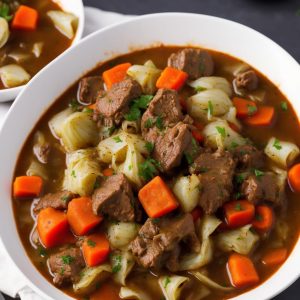This Italian beef stew is a comforting and hearty dish, perfect for a cozy family dinner. The tender beef is beautifully complemented by a rich medley of vegetables and aromatic herbs. Slow-cooked to perfection, every bite offers a burst of flavor that is both rustic and sophisticated.
When preparing this recipe, you might need to pick up a few specific items from the supermarket. Cremini mushrooms add a savory depth, while russet potatoes provide a starchy balance. Fresh basil and parsley are essential for a bright finish. Make sure you have dried oregano, thyme, rosemary, and marjoram in your spice cabinet.
Ingredients for Italian Beef Stew
Celery ribs: Adds a crunchy texture and a fresh, slightly peppery taste.
Yellow onion: Provides a sweet and savory base flavor for the stew.
Garlic cloves: Enhances the dish with a robust, aromatic depth.
Olive oil: Used for sautéing and enriching the flavors of the ingredients.
Beef shoulder: A tender cut that becomes succulent when slow-cooked.
All-purpose flour: Helps in browning the beef and thickening the stew.
Salt: Essential for seasoning and enhancing flavors.
Freshly ground black pepper: Adds a subtle heat and sharpness.
Low-sodium beef broth: Forms the flavorful liquid base of the stew.
Red wine vinegar: Adds a slight acidity to balance the richness.
Tomatoes: Contributes a slightly sweet and tangy flavor.
Dried oregano: Offers a warm, aromatic note.
Dried thyme: Imparts a subtle, earthy flavor.
Dried rosemary: Provides a fragrant, pine-like aroma.
Dried marjoram: Adds a delicate, sweet herbaceous taste.
Bay leaves: Infuses the stew with a layer of complex flavor.
Cremini mushrooms: Adds an umami-rich, meaty texture.
Carrots: Contributes a natural sweetness and vibrant color.
Russet potatoes: Provides a hearty, starchy element.
Fresh basil: Brightens the stew with a fresh, peppery taste.
Fresh parsley: Adds a clean, slightly peppery finish.
Parmesan cheese: Optional, for a rich, salty garnish.
One reader, Durante Mcmahon says:





This Italian beef stew recipe is a winner! The flavors are rich and comforting, and the beef turns out incredibly tender. The blend of herbs and fresh basil adds a delightful touch. Perfect for a cozy dinner.
Mastering the Techniques for Italian Beef Stew
How to sauté vegetables: Heat olive oil in a pot over medium-high heat, add vegetables like celery and onion, and cook until they are softened and slightly caramelized. How to coat beef in flour: Place beef in a resealable bag with flour, salt, and pepper, then seal the bag and shake it to evenly coat the beef. How to brown beef: Heat oil in a pot over medium-high heat, add the beef, and cook until all sides are browned, which helps to develop flavor. How to deglaze a pot: Add liquid (like broth and vinegar) to the pot after browning meat, then stir and scrape the bottom to release any browned bits, which adds depth to the sauce. How to simmer stew: Reduce heat to low after bringing the mixture to a boil, cover the pot, and cook slowly to allow flavors to meld and ingredients to become tender.
How To Make Italian Beef Stew
Our hearty beef stew recipe makes the perfect meal to serve at big dinner parties! It’s a deliciously seasoned one-pot meal for easy cooking.
Serves:
Ingredients
- 3celery ribschopped into ½-inch thick pieces
- 1large yellow oniondiced
- 4garlic clovesfinely minced
- 5tbspolive oildivided
- 2½lbsbeef shoulderchuck roast or rump roast, trimmed of fat and cut into 1-inch pieces
- ⅓cupall-purpose flour
- salt and freshly ground black pepper
- 4cupslow-sodium beef broth
- 1tbspred wine vinegar
- 15oztomatoesdiced
- 1tspdried oregano
- 1tspdried thyme
- ¾tspdried rosemarycrushed
- ½tspdried marjoram
- 2bay leaves
- 8ozcremini mushroomoptional
- 4medium carrotschopped into ½-inch thick pieces
- 1½lbsRusset potatoespeeled and diced into 1-inch pieces
- 3tbspfresh basilchopped
- 3tbspfresh parsleychopped
- Parmesan cheeseor Romano cheese, optional
Instructions
-
Heat 1 tablespoon of olive oil in a large enameled cast iron pot over medium-high heat.
-
Add the celery and onion, then sauté for 4 minutes.
-
Add the garlic and sauté for 1 minute longer.
-
Pour the mixture into a heat proof bowl, then set aside.
-
Place the beef in a large resealable bag.
-
Add the flour and season with 1 teaspoon of salt and ½ teaspoon of pepper.
-
Seal bag, then toss well to evenly coat the beef in the flour.
-
Return the pot to medium-high heat, then add the remaining 3 tablespoons of olive oil.
-
Once the oil is hot, add half of the beef.
-
Cook for 4 to 5 minutes, tossing occasionally until the beef has browned.
-
Transfer the browned beef to a plate.
-
Add another 1 tablespoon of oil to the pot, then add the remaining half of the beef to brown.
-
Slowly add 1 cup of broth, red wine vinegar, and the beef on the plate.
-
Cook, stirring frequently while scraping the bottom of pan, until the sauce has thickened.
-
Add the remaining 3 cups of beef broth, diced tomatoes, oregano, thyme, rosemary, marjoram, bay leaves, mushrooms and sautéed veggie mixture.
-
Bring the mixture just to a boil, stirring frequently.
-
Season with salt and pepper to taste.
-
Reduce the heat to low, then cover the pot and simmer for 1½ hours, stirring occasionally.
-
Add the potatoes and carrots, then cook about 1½ hours longer until the beef and vegetables are tender.
-
Serve warm with a sprinkle of fresh basil, parsley, and parmesan, if desired, and enjoy!
Nutrition
- Calories: 472.36kcal
- Fat: 20.16g
- Saturated Fat: 4.87g
- Trans Fat: 0.32g
- Monounsaturated Fat: 12.73g
- Polyunsaturated Fat: 2.11g
- Carbohydrates: 32.21g
- Fiber: 3.74g
- Sugar: 4.71g
- Protein: 40.54g
- Cholesterol: 92.34mg
- Sodium: 1284.93mg
- Calcium: 79.04mg
- Potassium: 1640.58mg
- Iron: 6.10mg
- Vitamin A: 40.88µg
- Vitamin C: 19.15mg
Crucial Technique Tip for Perfect Italian Beef Stew
When browning the beef, make sure not to overcrowd the pot. Browning in batches ensures that each piece gets a nice sear, which adds depth of flavor to the stew. Overcrowding can cause the beef to steam rather than brown, resulting in a less flavorful dish.
Time-Saving Tips for Italian Beef Stew
Pre-chop vegetables: Prepare celery, onion, garlic, carrots, and potatoes in advance to save time during cooking.
Use pre-cut beef: Purchase pre-cut beef shoulder to skip the cutting step.
One-pot cooking: Utilize a large enameled cast iron pot to minimize cleanup and streamline the cooking process.
Batch browning: Brown the beef in batches to ensure even cooking and better flavor.
Simmer while prepping: While the stew simmers, use the time to prepare fresh basil and parsley for garnish.
Substitute Ingredients For Italian Beef Stew Recipe
celery ribs - Substitute with fennel stalks: Fennel stalks provide a similar crunchy texture and a slightly different but pleasant flavor.
yellow onion - Substitute with red onion: Red onions offer a milder taste and can add a bit of color to the stew.
garlic cloves - Substitute with garlic powder: Use 1/8 teaspoon of garlic powder for each clove to maintain the garlic flavor.
olive oil - Substitute with canola oil: Canola oil has a neutral flavor and a similar smoke point, making it a good alternative for cooking.
beef shoulder - Substitute with chuck roast: Chuck roast has a similar texture and marbling, making it a suitable replacement for beef shoulder.
all-purpose flour - Substitute with cornstarch: Cornstarch can be used as a thickening agent, but use half the amount of flour called for.
beef broth - Substitute with chicken broth: Chicken broth can be used in a pinch, though it will slightly alter the flavor profile.
red wine vinegar - Substitute with balsamic vinegar: Balsamic vinegar adds a rich, slightly sweet flavor that complements the stew.
tomatoes - Substitute with tomato sauce: Tomato sauce can provide a similar tomato flavor and consistency.
dried oregano - Substitute with dried basil: Dried basil offers a different but complementary herbal note.
dried thyme - Substitute with dried sage: Dried sage provides a similar earthy flavor.
dried rosemary - Substitute with dried tarragon: Dried tarragon has a slightly different but aromatic flavor.
dried marjoram - Substitute with dried basil: Dried basil can provide a similar herbal note.
bay leaves - Substitute with thyme sprigs: Thyme sprigs can add a similar depth of flavor.
cremini mushroom - Substitute with button mushrooms: Button mushrooms have a similar texture and flavor profile.
carrots - Substitute with parsnips: Parsnips offer a similar texture with a slightly sweeter taste.
russet potatoes - Substitute with yukon gold potatoes: Yukon gold potatoes have a similar starchy texture and hold up well in stews.
fresh basil - Substitute with fresh cilantro: Fresh cilantro provides a different but fresh and vibrant flavor.
fresh parsley - Substitute with fresh cilantro: Fresh cilantro can add a similar fresh note.
parmesan cheese - Substitute with pecorino romano: Pecorino Romano offers a similar salty and tangy flavor.
Presenting Your Italian Beef Stew
Use a deep, wide-rimmed bowl: Select a pristine white bowl with a wide rim to allow the vibrant colors of the Italian beef stew to stand out.
Layer the stew artfully: Spoon a generous portion of the beef and vegetables into the center of the bowl, ensuring a balanced mix of beef, potatoes, carrots, and mushrooms.
Garnish with fresh herbs: Finely chop fresh basil and parsley, then sprinkle them delicately over the top of the stew to add a burst of color and freshness.
Add a parmesan crisp: Create a parmesan crisp by baking grated parmesan cheese in small rounds until golden and crispy. Place one crisp standing upright in the center of the stew for an elegant touch.
Drizzle with olive oil: Finish with a light drizzle of high-quality olive oil around the edge of the stew to add a glossy sheen and enhance the flavors.
Serve with artisan bread: Accompany the stew with a slice of toasted artisan bread, brushed with olive oil and a hint of garlic, placed elegantly on the side of the bowl.
Use microgreens for a final touch: Add a small handful of microgreens on top of the stew for a sophisticated and modern presentation.
Present on a wooden board: Place the bowl on a rustic wooden board to contrast with the refined presentation, adding a touch of warmth and homeliness to the dish.
Essential Tools for Making Italian Beef Stew
Large enameled cast iron pot: This is essential for browning the beef and simmering the stew. It retains heat well and ensures even cooking.
Heat proof bowl: Used to temporarily hold the sautéed celery, onion, and garlic mixture.
Large resealable bag: Perfect for coating the beef with flour, salt, and pepper without making a mess.
Tongs: Handy for turning the beef pieces while browning them in the pot.
Wooden spoon: Ideal for stirring the stew and scraping the bottom of the pot to incorporate all the flavorful bits.
Measuring spoons: Necessary for accurately measuring out the olive oil, salt, pepper, red wine vinegar, and dried herbs.
Measuring cups: Used for measuring the beef broth and diced tomatoes.
Chef's knife: Essential for chopping the celery, onion, garlic, mushrooms, carrots, and potatoes.
Cutting board: Provides a safe surface for chopping all the vegetables and herbs.
Plate: Used to hold the browned beef temporarily before adding it back to the pot.
Can opener: Necessary for opening the can of tomatoes.
Ladle: Useful for serving the stew once it's done.
Grater: Needed if you choose to sprinkle parmesan cheese on top of the stew before serving.
Storing and Freezing Your Italian Beef Stew
- Allow the beef stew to cool completely before storing or freezing.
- For storing in the refrigerator, transfer the cooled stew to an airtight container and keep it refrigerated for up to 4 days.
- When ready to reheat, place the desired portion in a saucepan over medium heat, stirring occasionally until heated through.
- If the stew appears too thick, add a splash of beef broth or water to thin it out.
- For freezing, transfer the cooled stew to freezer-safe containers or resealable bags, leaving about an inch of space at the top for expansion.
- Label the containers or bags with the date and contents, then place them in the freezer for up to 3 months.
- To thaw frozen beef stew, transfer it to the refrigerator overnight or place the container in a bowl of cold water, changing the water every 30 minutes until the stew is thawed.
- Reheat the thawed stew in a saucepan over medium heat, stirring occasionally, until it reaches the desired temperature.
- If the stew appears too thick after thawing, add a small amount of beef broth or water to achieve the desired consistency.
- For best results, consume the reheated stew within 2 days of thawing.
How To Reheat Leftover Italian Beef Stew
Reheat the italian beef stew in a pot on the stove over medium-low heat, stirring occasionally, until it reaches the desired temperature. This method allows you to control the heat and ensure that the stew is evenly reheated without overcooking the vegetables or meat.
If you're short on time, you can reheat the italian beef stew in the microwave. Transfer the desired portion to a microwave-safe bowl, cover it with a damp paper towel, and heat it in 1-minute intervals, stirring between each interval, until it's heated through. Be careful not to overheat the stew, as it may cause the meat to become tough.
For a slow and steady approach, reheat the italian beef stew in a slow cooker. Transfer the stew to the slow cooker, cover it, and heat it on low for 2-3 hours or until it's heated through. This method is perfect if you want to come home to a warm and comforting meal after a long day.
If you have an oven-safe dish, you can reheat the italian beef stew in the oven. Preheat the oven to 350°F (175°C), transfer the stew to the dish, cover it with foil, and bake for 20-30 minutes or until it's heated through. This method is ideal if you want to reheat a large portion of the stew at once.
For a quick and easy option, reheat individual portions of the italian beef stew in a toaster oven. Transfer the desired portion to an oven-safe dish, cover it with foil, and heat it at 350°F (175°C) for 10-15 minutes or until it's heated through. This method is perfect for reheating smaller portions without having to use the stove or oven.
Fascinating Facts About Italian Beef Stew
A unique aspect of this Italian beef stew recipe is the combination of dried herbs like oregano, thyme, rosemary, and marjoram, which infuse the stew with rich, aromatic flavors typical of traditional Italian cuisine.
Is Making Italian Beef Stew at Home Cost-Effective?
This Italian beef stew recipe is moderately cost-effective. The use of beef shoulder and fresh herbs like basil and parsley adds to the cost, but the bulk of the ingredients such as potatoes, carrots, and celery are relatively inexpensive. The overall verdict rating for this recipe is 7 out of 10. The approximate cost for a household of 4 people is around $25-$30 USD.
Is Italian Beef Stew Healthy or Unhealthy?
This Italian beef stew recipe has both healthy and unhealthy aspects. On the positive side, it includes a variety of nutritious vegetables like celery, onion, garlic, mushrooms, carrots, and potatoes. These ingredients provide essential vitamins, minerals, and fiber. The recipe also uses lean beef shoulder, which is a good source of protein.
However, there are some areas of concern:
- The recipe calls for a significant amount of olive oil, which is high in calories and fat
- The flour used for coating the beef adds extra carbohydrates and calories
- The beef broth, if not low-sodium, can contribute to a high sodium content
- The recipe lacks leafy greens or other colorful vegetables that would provide additional nutrients
To make this recipe healthier, consider the following suggestions:
- Reduce the amount of olive oil used, or opt for a lower-calorie cooking spray
- Replace half of the all-purpose flour with whole wheat flour for added fiber and nutrients
- Ensure that you use low-sodium beef broth to control the salt content
- Add more vegetables to the stew, such as diced zucchini, bell peppers, or leafy greens like spinach or kale
- Serve the stew with a side salad or steamed vegetables to increase the overall nutrient density of the meal
- Use a leaner cut of beef, such as sirloin or tenderloin, to reduce the fat content further
By incorporating these changes, you can enhance the nutritional value of this Italian beef stew while still maintaining its hearty and comforting flavors. The key is to strike a balance between taste and health, making small adjustments that can have a significant impact on the overall nutritional profile of the dish.
Editor's Opinion on This Italian Beef Stew Recipe
This Italian beef stew recipe is a robust and hearty dish, perfect for a comforting meal. The combination of beef shoulder, aromatic vegetables, and a medley of herbs creates a rich and flavorful broth. The use of red wine vinegar adds a subtle tang, enhancing the depth of the stew. The inclusion of cremini mushrooms, carrots, and russet potatoes ensures a well-rounded and satisfying texture. Fresh basil, parsley, and a sprinkle of parmesan cheese provide a fresh and savory finish. Overall, this recipe is well-balanced and sure to impress with its authentic Italian flavors.
Enhance Your Italian Beef Stew Recipe with These Unique Side Dishes:
Delicious Alternatives to Italian Beef Stew
Appetizers and Desserts to Complement Your Italian Beef Stew
Why trust this Italian Beef Stew Recipe:
This Italian beef stew recipe is crafted with care, using high-quality ingredients like beef shoulder, cremini mushrooms, and russet potatoes. The combination of dried herbs and fresh basil and parsley ensures a rich, authentic flavor. The step-by-step instructions are easy to follow, making it accessible for both novice and experienced cooks. Trust this recipe for a hearty, comforting meal that brings the taste of Italy to your table.
Was this page helpful?
Have your own special recipe to share? Submit Your Recipe Today!














